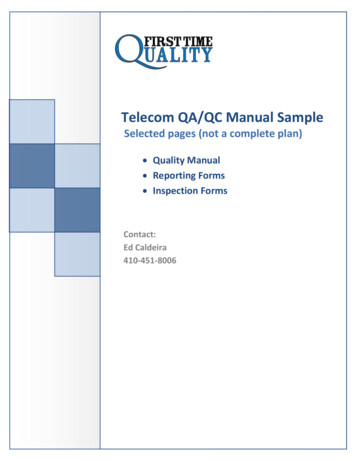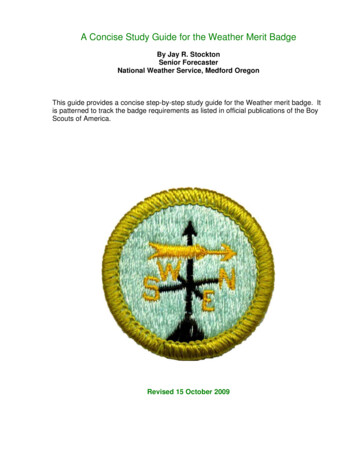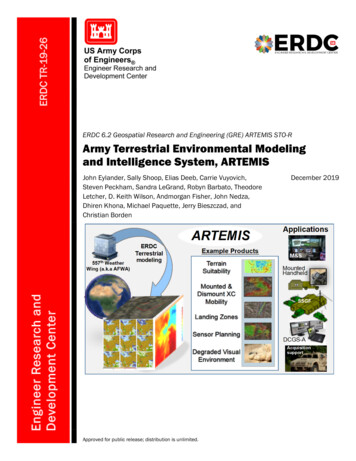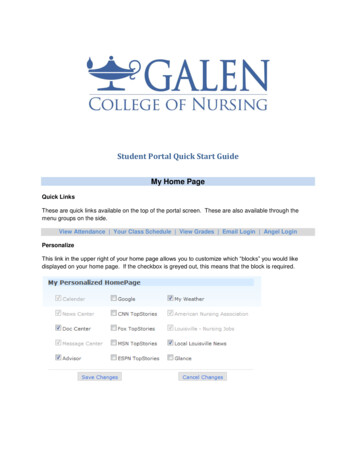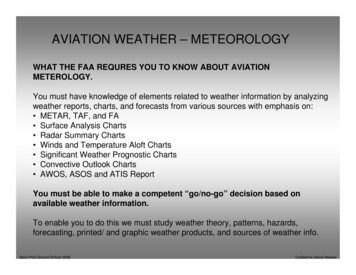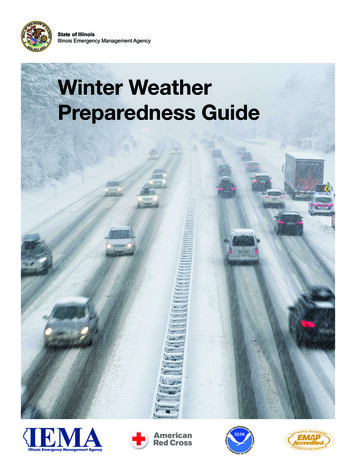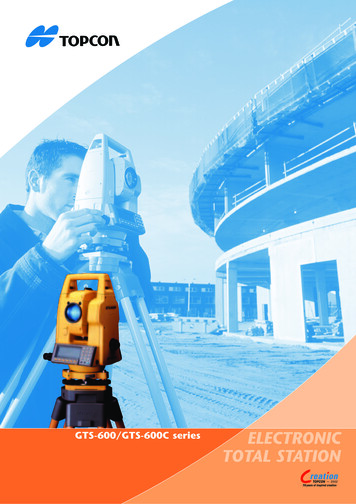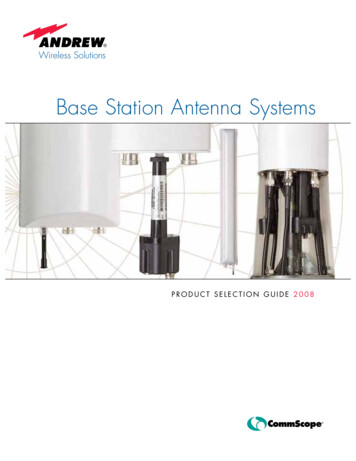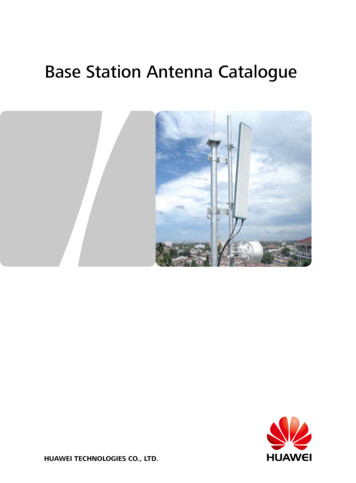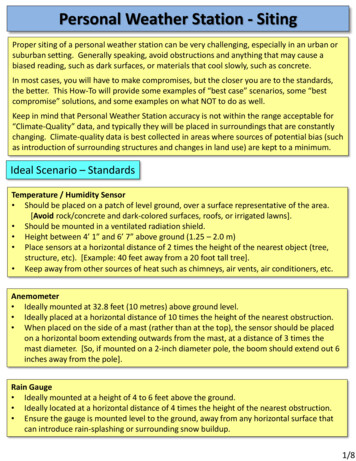
Transcription
Personal Weather Station - SitingProper siting of a personal weather station can be very challenging, especially in an urban orsuburban setting. Generally speaking, avoid obstructions and anything that may cause abiased reading, such as dark surfaces, or materials that cool slowly, such as concrete.In most cases, you will have to make compromises, but the closer you are to the standards,the better. This How-To will provide some examples of “best case” scenarios, some “bestcompromise” solutions, and some examples on what NOT to do as well.Keep in mind that Personal Weather Station accuracy is not within the range acceptable for“Climate-Quality” data, and typically they will be placed in surroundings that are constantlychanging. Climate-quality data is best collected in areas where sources of potential bias (suchas introduction of surrounding structures and changes in land use) are kept to a minimum.Ideal Scenario – StandardsTemperature / Humidity Sensor Should be placed on a patch of level ground, over a surface representative of the area.[Avoid rock/concrete and dark-colored surfaces, roofs, or irrigated lawns]. Should be mounted in a ventilated radiation shield. Height between 4’ 1” and 6’ 7” above ground (1.25 – 2.0 m) Place sensors at a horizontal distance of 2 times the height of the nearest object (tree,structure, etc). [Example: 40 feet away from a 20 foot tall tree]. Keep away from other sources of heat such as chimneys, air vents, air conditioners, etc.Anemometer Ideally mounted at 32.8 feet (10 metres) above ground level. Ideally placed at a horizontal distance of 10 times the height of the nearest obstruction. When placed on the side of a mast (rather than at the top), the sensor should be placedon a horizontal boom extending outwards from the mast, at a distance of 3 times themast diameter. [So, if mounted on a 2-inch diameter pole, the boom should extend out 6inches away from the pole].Rain Gauge Ideally mounted at a height of 4 to 6 feet above the ground. Ideally located at a horizontal distance of 4 times the height of the nearest obstruction. Ensure the gauge is mounted level to the ground, away from any horizontal surface thatcan introduce rain-splashing or surrounding snow buildup.1/8
Personal Weather Station - SitingReality CheckWelcome to the Desert Southwest, where suburbanhouses are built on top of one another, fences are madeof stone or concrete, and back yards are crushed rock orartificially irrigated turf grass. In some cases, lack ofspace, Home Owners’ Association rules, and aestheticsmay make it impossible to ideally place weatherequipment. You can usually find an acceptablecompromise for temperature, humidity, and precipitation,but the biggest challenge will be anemometer placement.Station Placement in Rural AreasThe best tip here is “if you’ve got land, use it!” If your home orbusiness is in a rural area, you are likely to have more space tokeep your instrumentation as far from structures as possible, andless likely to have landowner covenants or HomeownersAssociation rules to abide by. Consider using wireless equipmentto avoid the hassles of running long lengths of wire.LEFT: This is about as ideal as you can get. Anemometer is at 10m(32.8’) above ground level (AGL), Temp/Humidity sensor is at 5’AGL. Surrounding terrain is flat, with a natural, regionallyrepresentative surface. The anemometer mast has cable stays toavoid flexing. At 32.8’, cable stays are essential, unless you aremounting a much larger tower/sturdier structure.RIGHT: All-in-one units can relieve you of messy wires, but force youto compromise between the ideal height for temp/humidity/rainsensors, and ideal height for the anemometer. The best bet is to gosomewhere in-between. This station appears to be about 6-7 feetoff the ground, not ideal for the anemometer, but an acceptablecompromise, especially if the anemometer height can be noted inmetadata. Keep in mind that if you mount an all-in-one station highup, it will require more work to keep the rain gauge funnel clear ofdebris.2/8
Personal Weather Station - SitingLEFT: The temp/humidity sensor is at an ideal heightover representative ground cover. The rain gauge is at agood height to avoid dog-watering by the “WeatherLab.”However, the anemometer is only at about 6’ AGL.Mounting a free-standing pole much higher than thiswithout using cable stays can be difficult, and might nothave been acceptable to the landowner, in which casethis is a good compromise.The anemometer height should be noted in stationmetadata. From a NWS perspective, peak gustinformation from this site would still be useful, but weprobably would not want to use wind data for surfaceanalysis without applying a correction factor, as it wouldhave a low-biased wind speed against standard mountedequipment.Station Placement in Suburban AreasSmaller yards, nearby structures, variable groundcover, and HOA rules for aesthetics can makeplacing a weather station in residential suburbanareas a challenge.The principles remain the same – get theanemometer as close to 10 metres AGL as possible,and keep the temp/humidity sensor and rain gaugeas far from obstructions as possible. Stay awayfrom pavement, rock walls, irrigated lawns, andswimming pools.When mounting anyequipment on astructure, be sure to runa ground wire!RIGHT: Antenna masts are a great place to mountan anemometer, but not the temperature sensor.The anemometers here are both technically “toolow” but the one on the right is at a very goodcompromise height. The one on the left would bestbe raised a little higher.Eave cross-mounts can prevent you from having todrill into your roof.3/8
Personal Weather Station - SitingLEFT: Chimneys can provide a nice, solid structurefor mounting an extension pole. Chimney mountsdesigned for antennas can be purchased in mosthome improvement and electronics stores.While this is likely below 10 metres AGL, this is agood compromise height that is low-impact (noholes drilled) and aesthetically not distracting (nocable stays).This station (Davis Vantage Pro 2?) uses anoptional wireless transmitter kit for theanemometer, allowing the anemometer to bemounted far from the Rain Gauge andTemp/Humidity sensor suite.RIGHT: A 4x4 post buried a few feet into theground is an excellent mounting option for yourrain gauge and temp/humidity sensor.Periodically check to ensure that it is plumb andlevel, especially if you are in an area prone tofrost-heaving.If you are concerned about aesthetics, considerusing lumber that is more attractive whenunfinished, such as cedar. It is probably best tonot paint the post a dark color!4/8
Weather Station Siting – Bad Examples!LEFT: This anemometer is mounted far toolow relative to the roof line. The winddirection will be heavily influenced by thepeak of the roof, and the wind speed willbe erratic as the roof may enhance orblock the wind, depending on thedirection.RIGHT: This temperature/humidity sensoris mounted too close to this structure.Heat will radiate from the walls, eaves, andsoffit through the day. A pocket of warmair will likely develop under the eave atnight. This will result in a major warmbias. The rain gauge may also be blockedfrom the right depending on the winddirection and roof pitch, and heavyraindrops may splash into the gauge fromthe nearby roof.LEFT: If you do this, you’re just begging forbirds’ nest in your rain gauge funnel!Wind speed and direction is likely to be erraticdue to turbulence around the tree branches.Temperature may run a little high during theday due to radiation off the tree limb.5/8
Weather Station Siting – Bad Examples!LEFT: Station notes indicated that this is aninactive chimney, but the temperature andhumidity sensor is still too close to the blacktar shingle roof. The brick also is likely toradiate heat.RIGHT: This weather rock isclearly mounted too low to theground, not far enough fromnearby structures, and too closeto pavement.6/8
Weather Station Siting – Good Examples!LEFT: This sensor suite is far from obstructions,with the anemometer mounted at about 10 m,and temp/humidity/rain gauge sensor suiteabout 5-6 feet AGL. Hopefully there are cablestays to prevent wobbling.7/8
Further Detailed ReadingCWOP – Weather Station Siting, Performance, and Data Quality -OfficialGuide.pdfThe following are NOT “light” reading World Meteorological Organization – Guide to Meteorological Instrumentsand Methods of t/CWOP-WMO8.pdfWorld Meteorological Organization – Initial Guidance to ObtainRepresentative Meteorological Observations at Urban -WMO1250.pdfDocument last updated 08/13/2016. Images and data contained herein are for informationalpurposes only and are not intended to imply endorsement of any particular weatherstation/manufacturer, software package/developer.8/8
Aug 13, 2016 · Keep in mind that Personal Weather Station accuracy is not within the range acceptable for “Climate-Quality” data, and typically they will be placed in surroundings that are constan
